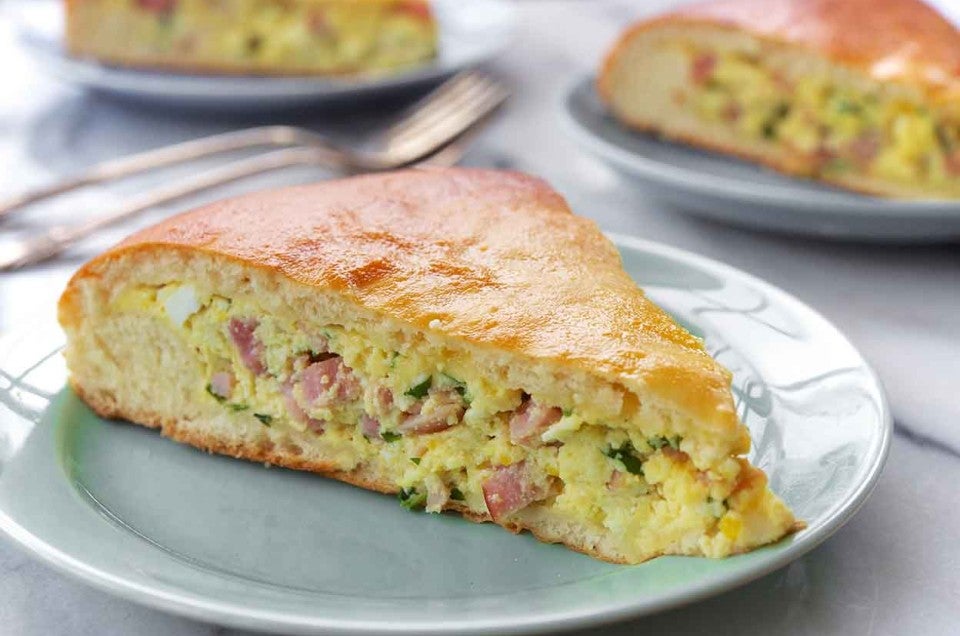


I’ve no doubt baked many hundreds of different recipes in the 35+ years I’ve been baking on my own. But there are certain ones that I bake over and over again: fudge birthday cake, almond puff loaf, whole wheat pain de mie, and a host of others that never fail to win accolades from whatever audience enjoys them.
Then there are the recipes I make over and over again… but only once a year.
Dark chocolate buttercrunch at Christmas. Some version of pineapple upside-down cake (the particular recipe varies from year to year) on my husband’s birthday. Pistachio cookies for St. Patrick’s Day; and Easter Pie, which today I made for the 34th time. (I know it’s 34 times because we were married in August, 1976 and I’ve made it every Easter since, without fail.)
Easter pie isn’t sweet. And it’s not made with a traditional pie crust. It’s a pie in the same sense that “pizza pie” is pie; it has a top and bottom crust with filling in between.
Easter pie’s not assertively flavored; it’s not over-the-top handsome. It’s more like a comfortable old shoe, something that’s beloved by sheer dint of its familiarity. Easter pie, in our house, is true comfort food.
I got this recipe from my grandma-in-law, not long before she passed away over 25 years ago. A typical Italian grandma, she didn’t have anything written down, and scoffed when I asked her if she had a recipe.
But between watching her, then watching my mother-in-law (her daughter), I learned. And I wrote down the recipe. Because this is a recipe that needs to get passed along. Perhaps to my son, who’s gradually learning to cook now that he’s out on his own. Perhaps to his wife, if he finds one someday. But certainly to anyone browsing through the recipe archive on the King Arthur Flour Web site, where this recipe now lives.
So, while it may be too late for you to add this to your list of Easter recipes this year, I wanted to share it with you anyway. There’s always next year… and the year after… and the 30 or 40 or 50 years after that.
Some recipes truly do stand the test of time. And Easter Pie is one of them.

Place the following in a mixing bowl:

Mix everything together to make a rough dough.

Switch to the dough hook, and knead for about 7 minutes, until the dough is smooth and satiny.

Place the dough in a lightly greased bowl, or in an 8-cup measure — which makes it easy to track its progress as it rises.
While the dough is rising, make the filling.
Gather the following:

Place the hard-boiled eggs, ham (cut in chunks), and fresh parsley (1/2 cup or so) in the work bowl of a food processor. Process until chopped and combined. Don't over-process; the ham and eggs should still be a bit chunky.
You can also simply dice the eggs and ham, and chop the parsley, if you don't have a food processor.

Combine the ham, boiled eggs, and parsley with the raw eggs, ricotta, Parmesan, and about 1/2 teaspoon coarsely ground black pepper.

Stir to combine. Season to taste with salt. If the ham is salty, you may not need any salt at all.

Back to the dough. Nice rise!

Deflate the dough, and divide it into four pieces.

Roll each piece into a 13" circle, if you have two 12" or 14" round pizza pans; or into ovals about 10” x 14”. Rolling on parchment will make it easy to move the crusts onto the pans.
I've chosen to roll ovals.

As you roll the crusts, stack them (with the parchment) atop one another, so the first ones don't dry out before the last one is done.
Place two of the crusts on pans. These are the bottom crusts.

Divide the filling evenly between the two bottom crusts; you'll use a generous 3 cups (about 27 ounces) for each crust.

Spread the filling to within 1" of the edge of each crust.

Use the parchment as an aide to place the remaining crusts atop the filled crusts.

Like this.

Seal the crust edges by rolling the bottom crust up over the top, and pinching together.

Using a sharp knife or pair of scissors, cut a 1" hole in the very center of each top crust; this will allow steam to escape.
Now, for the glaze. Combine 1 large egg and 2 tablespoons sugar.

Whisk until the sugar dissolves.

Paint each crust with some of the topping.

This will yield a golden brown, shiny crust with mildly sweet flavor, a perfect foil for the salty ham.
Allow the pies to rest while you preheat your oven to 350°F, about 15 minutes. They don't need to be covered.

Bake the pies for about 25 minutes...

...until they're a deep, golden brown.

Remove them from the oven, and carefully slide them off the pan/parchment and onto on a rack to cool.

Light, thin crust; ham, cheese, eggs; shiny/mildly sweet glaze. That's Easter Pie!

Serve the pie cut in wedges or squares. It's traditionally NOT served warm, and NOT served on a plate, at least in our house. You can be more formal, and serve on a plate, with a fork; but we simply eat it out of hand. It holds together well, and makes a great snack, something to enjoy while you're trailing the kids around on their Easter egg hunt.
Read, rate, and review (please) our recipe for Italian Easter Pie.


